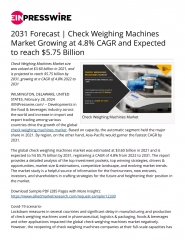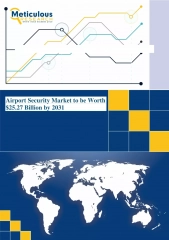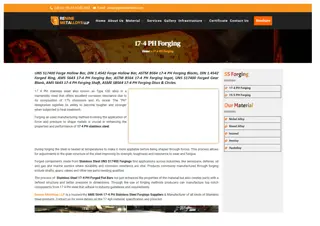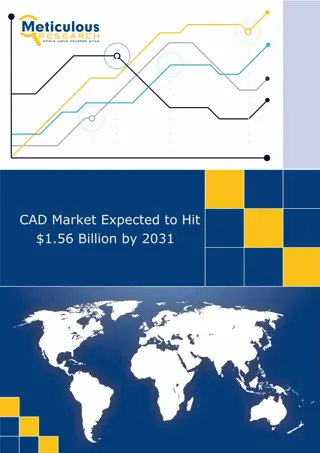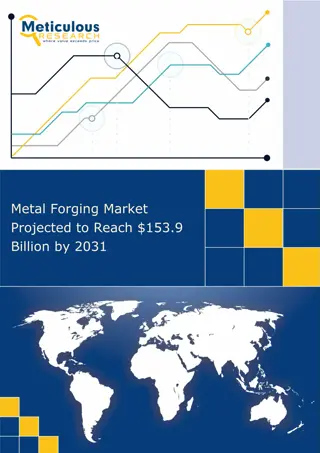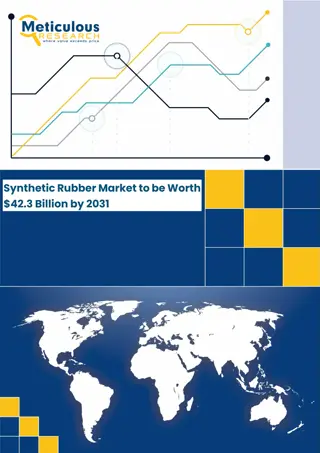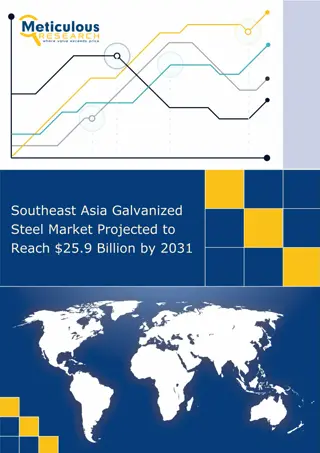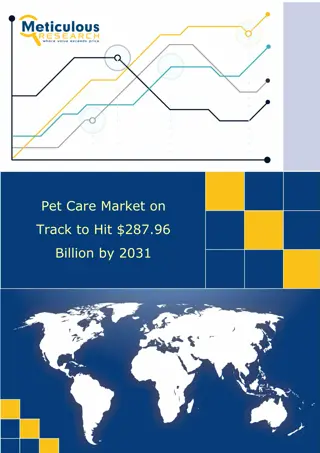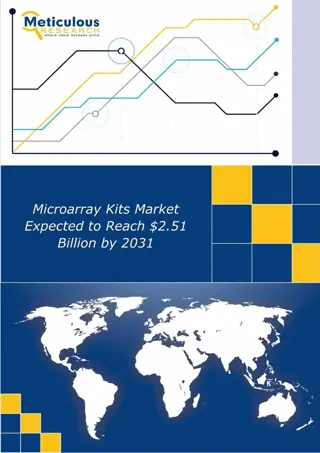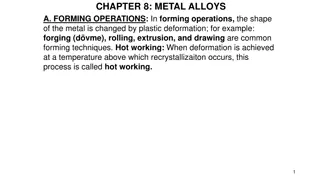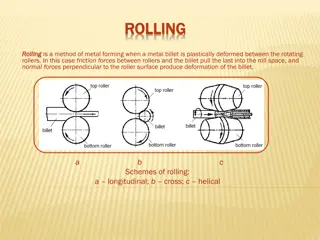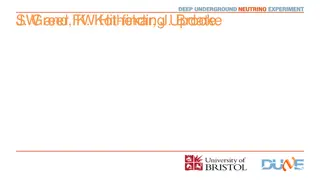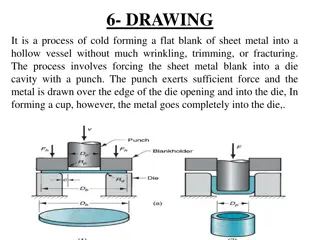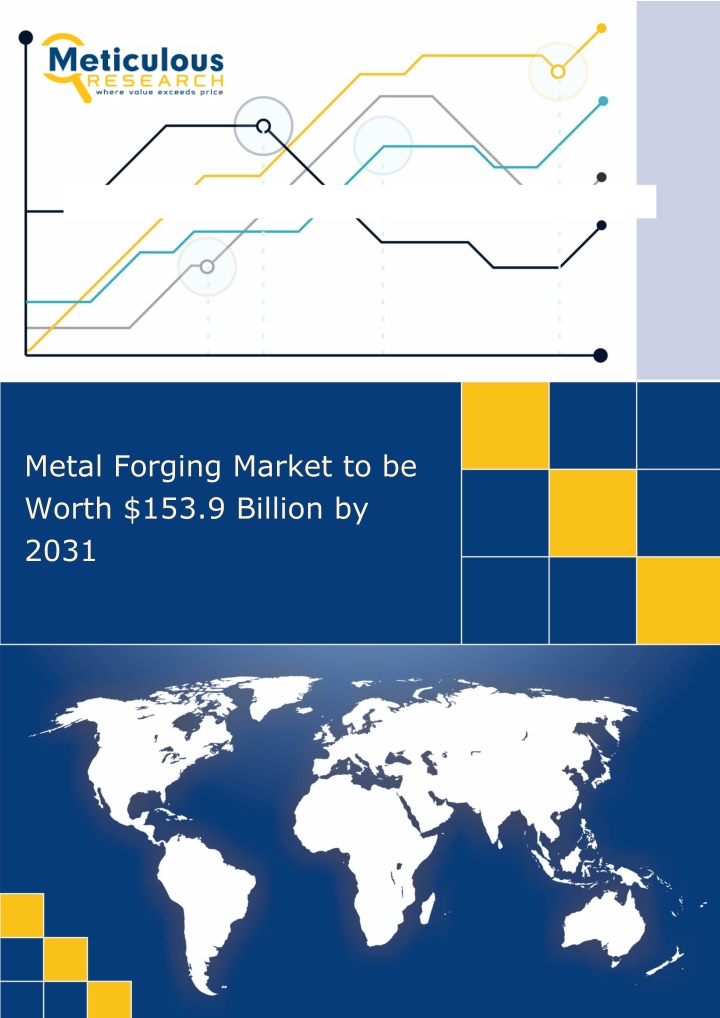
Metal Forging Market Expected to Hit $153.9 Billion by 2031
Explore $153.9 billion metal forging market: Get exclusive insights on key market trends, segments, geographical analysis, & competitive analysis!n
Download Presentation

Please find below an Image/Link to download the presentation.
The content on the website is provided AS IS for your information and personal use only. It may not be sold, licensed, or shared on other websites without obtaining consent from the author. If you encounter any issues during the download, it is possible that the publisher has removed the file from their server.
You are allowed to download the files provided on this website for personal or commercial use, subject to the condition that they are used lawfully. All files are the property of their respective owners.
The content on the website is provided AS IS for your information and personal use only. It may not be sold, licensed, or shared on other websites without obtaining consent from the author.
E N D
Presentation Transcript
Metal Forging Market to be Worth $153.9 Billion by 2031
Global Metal Forging Market 2024-2031 Meticulous Research a leading global market research company, published a research report titled, Metal Forging Market by Method (Closed Die Forging, Open Die Forging, Cold Forging,Roll Forging), Material (Steel, Aluminum, (Automotive, Oil & Gas,Construction), and Geography Global Forecast to 2031. Titanium), End-use Industry According to this latest publication from Meticulous Research , the metal forging market is expected to reach $153.9 billion by 2031, at a CAGR of 7.4% from 2024 2031. The growth of the metal forging market is driven by the rising infrastructure development and growing commercial aircraft production. However, the intensive energy consumption and fluctuating raw material costs and availability may restrain the growth of this market. Furthermore, the adoption of industry 4.0 technology and advancements in forging technology are expected to offer significant growth opportunities for players operating in the metal forging market. However, the supply chain disruptions and regulatory compliance complexity may hinder the growth of this market. The metal forging market is segmented into method (closed die forging, open die forging, cold forging, roll forging, upset forging, and other methods), material (steel, aluminum, titanium, nickel alloys, magnesium, and other materials), and end-use industry (automotive, oil & gas, aerospace & defense, construction, agriculture, machines & tools, mining & metals, and other end-use industries). The study also evaluates industry competitors and analyzes the market at the regional and country levels. Based on method, the metal forging market is segmented into closed die forging, open die forging, cold forging, roll forging, upset forging, and other methods. In 2024, the open die forging segment is expected to account for the largest share of above 49.0% of the metal forging market. The growth of this segment is attributed to its ability to produce a wide range of shapes and sizes, from simple bars to complex geometries. This versatility attracts industries with diverse forging needs, including aerospace, automotive, oil and gas, construction, and heavy machinery. Open die forging also offers flexibility in production volumes. It can efficiently produce both small batches and large quantities of parts, allowing manufacturers to adapt to varying market demands and customer orders without significant retooling or setup costs. However, the cold forging segment is projected to register the highest CAGR during the forecast period. The growth of this segment can be attributed to various factors, as it enhances the mechanical properties of the forged parts, such as strength, hardness, and durability. The cold working process strengthens the metal by inducing strain hardening and aligning the grain structure, resulting in parts with superior mechanical performance. These enhanced properties make cold-forged components desirable for applications requiring high strength and reliability, such as automotive, aerospace, and industrial equipment. Cold forging is a high-speed manufacturing process capable of producing parts at a rapid rate. Page 1 of 4 Meticulous Research| sales@meticulousresearch.com
Global Metal Forging Market 2024-2031 With advancements in technology and automation, cold forging systems can achieve high production volumes while maintaining consistent quality. Based on material, the metal forging market is segmented into steel, aluminum, titanium, nickel alloys, magnesium, and other materials. In 2024, the steel segment is expected to account for the largest share of above 44.0% of the metal forging market. The growth of this segment is attributed to various factors, as steel is renowned for its exceptional strength and durability, making it a preferred material for forging applications. Forged steel components exhibit superior mechanical properties, including high tensile strength, toughness, and resistance to wear and fatigue. These properties make forged steel parts ideal for critical applications in industries such as automotive, aerospace, oil and gas, construction, and power generation. Moreover, steel forging offers tight control over the metallurgical properties of the finished parts, ensuring consistent quality and performance. The forging process refines the grain structure of the steel, eliminating defects and enhancing the mechanical properties of the material. This results in forged steel components with superior strength, toughness, and dimensional accuracy, meeting the stringent quality standards of industries such as automotive and aerospace. However, the aluminum segment is projected to register the highest CAGR during the forecast period. The growth of this segment can be attributed to various factors, as aluminum has a low density and lightweight characteristics, making it an ideal material for applications where weight reduction is critical. Forged aluminum components offer high strength-to-weight ratios, making them suitable for aerospace, automotive, and transportation industries seeking to improve fuel efficiency and performance. Moreover, aluminum exhibits excellent thermal and electrical conductivity properties, making it a preferred choice for heat transfer and electrical applications. Forged aluminum heat sinks, electrical connectors, and transmission components benefit from these properties, ensuring efficient energy transfer and thermal management in various electronic and automotive systems. Based on end-use industry, the metal forging market is segmented into automotive, oil & gas, aerospace & defense, construction, agriculture, machines & tools, mining & metals, and other end-use industries. In 2024, the automotive segment is expected to account for the largest share of above 66.0% of the metal forging market. Metal forging is widely used in the production of critical engine components such as crankshafts, connecting rods, camshafts, and pistons. These components undergo high levels of stress and must withstand extreme operating conditions. Forged steel or aluminum alloys offer the necessary strength, durability, and fatigue resistance required for engine performance and reliability. Also, forged steel components are used in the construction of vehicle chassis and structural members to enhance rigidity, crashworthiness, and occupant safety. Metal forging is also utilized in the Page 2 of 4 Meticulous Research| sales@meticulousresearch.com
Global Metal Forging Market 2024-2031 production of wheel hubs, bearings, and other wheel-related components. Forged wheel hubs provide the necessary strength and durability to support vehicle loads and withstand dynamic forces during braking, acceleration, and cornering. Such factors help to drive the growth of the metal forging market for automotive during the forecast period. However, the construction segment is projected to register the highest CAGR during the forecast period. Metal forging is utilized in construction for a variety of applications where strength, durability, and precision are paramount. Forged steel components are integral to the construction of buildings, bridges, and other infrastructure projects. Structural steel forgings such as beams, columns, and girders provide the framework and support necessary to withstand the structural loads and forces imposed by the built environment in which forging ensures the required strength, stiffness, and dimensional accuracy of structural components, contributing to the overall stability and safety of construction projects. Additionally, metal forging is used in the manufacture of pile driving equipment used for foundation construction and deep excavation projects, and it ensures the durability, impact resistance, and precision alignment of pile driving components to achieve efficient and reliable pile installation in various soil conditions. Such factors help to drive the growth of the metal forging market for construction during the forecast period. Based on geography, the metal forging market is segmented into North America, Europe, Asia-Pacific, Latin America, and the Middle East & Africa. In 2024, Asia-Pacific is expected to account for the largest share of above 51.0% of the metal forging market. The Asia-Pacific region, particularly countries like China, India, Japan, and South Korea, has been experiencing rapid industrialization and infrastructure development. This growth has led to increased demand for forged metal components in sectors such as automotive, construction, aerospace, energy, and manufacturing. Advancements in forging technology, materials, and processes have improved the efficiency, quality, and capabilities of metal forging in the Asia- Pacific region. Automation, robotics, computer numerical control (CNC) machining, and simulation software enhance the productivity, accuracy, and flexibility of forging operations. These technological advancements drive the adoption of metal forging in various industries and support the region's manufacturing competitiveness. Moreover, the market in Asia-Pacific is also projected to register the highest CAGR of 8.5% during the forecast period. Key Players The key players operating in the metal forging market include Arconic Corporation (U.S.), Nippon Steel Corporation (Japan), Precision Castparts Corp. (U.S.), Larsen & Toubro Limited (India), Bharat Forge Limited (India), thyssenkrupp AG (Germany), BR CK GmbH (Germany), ELLWOOD Group, Inc. (U.S.), Metal Forging Pvt. Ltd. (India), CELSA Group (Spain) Ovako AB (Sweden), Lolu Alloys Ltd (U.K.), Scot Forge Company (U.S.), Alcoa Corporation (U.S.), and ATI Inc.(U.S.). Page 3 of 4 Meticulous Research| sales@meticulousresearch.com
Global Metal Forging Market 2024-2031 Download Sample Report Here @ https://www.meticulousresearch.com/download- sample-report/cp_id=5879 Key Questions Answered in the Report: What are the high-growth market segments in terms of method, material, and end- use industry? What is the historical market size for the metal forging market? What are the market forecasts and estimates for 2024 2031? What are the major drivers, restraints, opportunities, challenges, and trends in the metal forging market? Who are the major players in the metal forging market, and what are their market shares? What is the competitive landscape like? What are the recent developments in the metal forging market? What are the different strategies adopted by major market players? What are the trends and high-growth countries? Who are the local emerging players in the metal forging market, and how do they compete with other players? Contact Meticulous Email- sales@meticulousresearch.com Contact Connect with us on research Us: Research Sales- +1-646-781-8004 LinkedIn- https://www.linkedin.com/company/meticulous- Page 4 of 4 Meticulous Research| sales@meticulousresearch.com


